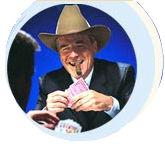The World Poker Tour recently released the third in its series of books on
poker, In the Money by Antonio “The Magician” Esfandiari. The book takes a
different approach than many of the recent poker books on the market,
providing readers with a guide on how to become a winning Texas Hold’em cash
game player.By eliminating the tournament aspect of poker, the format of the
book allows Esfandiari to focus solely on the game itself, rather than the
extra factors a tournament brings, such as chip stacks, increasing blind
levels, and tournament payouts.
Perhaps the best part of the book, however, is its voice. Esfandiari fills
the book with stories about the games he’s played and the friends he’s made.
Whether it’s a heads-up match with Phil Hellmuth to determine his fee for a
magic show or the story about how he won the first poker tournament he
entered, In the Money is an entertaining read. Phil “The Unabomber” Laak
gives the reader an insight into Esfandiari’s personality in the foreword,
while Hellmuth and Annie Duke also provide interesting stories about the
author.
Esfandiari spends one chapter detailing the differences between Limit and No
Limit Hold’em. The concrete examples are excellent, such as how to play
pocket fives in late position, or the effect of a raise in Limit vs. No
Limit. Esfandiari explains the phrase “Limit Hold’em is a science, No Limit
Hold’em is an art,” and he makes it clear that he prefers the No Limit
version. No Limit Hold’em, in Esfandiari’s view, requires more skill, and is
also much more rewarding.
Esfandiari goes back and forth between Limit and No Limit Hold’em when
describing how to play each part of the hand. The transition, or lack
thereof, can be a bit confusing, and one can’t help but think that these
topics should have been covered in separate books. Esfandiari may have been
better served with a focus solely on No Limit Hold’em.
After discussing how to play in given situations, Esfandiari offers advice
on more abstract parts of the game, such as establishing a table image and
identifying the texture of the game (i.e. passive vs. aggressive). While the
section lacks specific guidelines, Esfandiari explains that these aspects of
poker can only be mastered with time and practice, and are therefore hard to
glean from a book.
Overall, the poker advice is a little thin, but it’s the perfect combination
of strategy and entertainment for someone just getting serious about the
game. Intermediate players will find a few nuggets of wisdom while getting a
refresher course, but players with a great deal of experience should look
elsewhere for advanced strategy.
